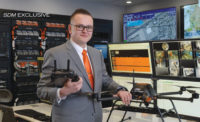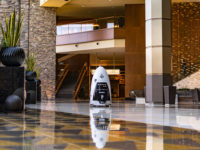Had you asked me 10 years ago, or even five, if SDM would ever feature an article about drones and robots as its cover story, my answer would have been “not likely.” Yet here we are, with “Is it Time for Security Drones & Robots?” as this month’s lead article. Security integrators are indeed interested in these technologies and identifying many uses for them within their security world.
“If you were to poll security systems integrators across the country, you would probably find few if any that are selling or promoting drones and robots as a solution or a means of profit. You’d be wrong, however, to assume there is little to no interest in the technologies by the security community,” states SDM’s Associate Editor Tim Scally in the article that begins on page 66.
The article profiles, among others, Allstate Security Industries, which is beginning to implement drones in its security monitoring and guard/patrol business in Amarillo, Texas. “By [February 2018] all of our operators will be FAA licensed so they can control the drone remotely…,” says Randall Renfroe, CEO, Allstate Security, in the article. “We’ll always have two [operators] on duty, and we’ll be able to deploy these drones out at locations not only in parking lots, campus security, and private neighborhoods — we can do agricultural businesses, new constructions, and our patrol and guard force will then be on-site to keep the drone in line-of-sight so that we can have three sets of eyes whenever we have a drone out there.”
In fact, if we as an industry weren’t on the cusp of accepting these technologies as useful and potentially lucrative, then we wouldn’t be seeing the return of Reed Exhibitions’ Unmanned Security & Safety Expo @ ISC West. The expo will feature unmanned aerial vehicles (UAVs), unmanned ground robotics and vehicles (UGVs), counter-drone solutions and the various software and applications that support them.
Other good reading on the subject is IFSEC Global’s, “The security drones report 2017.” You can download the PDF for no charge here.
Drone-service provider Aviat Drones commissioned the report to gauge how widely both drone and anti-drone technology is already used in the security industry and the level of demand among those yet to deploy it. The report also set out to ascertain levels of demand for various applications, from aerial surveillance to license plate identification and thermal imaging. The survey was completed by hundreds of security professionals, facility managers and senior executives from around the world (although the United Kingdom accounted for the largest portion).
“Drones are already more widely used in the security industry than many might have [realized], if our survey is any barometer,” the report states. “Sixteen percent of respondents — mostly comprising security professionals, heads of security and other senior executives — say they already deploy the technology. Given that a total of 60 percent either already uses drones or can foresee themselves doing so eventually, it doesn’t seem hyperbolic to describe the growth trajectory for this market as heading sharply upwards. ”
With use cases that range from under-populated (rural) areas to over-populated areas (too much vehicular traffic), from critical infrastructure to concerts and sporting events, from parking lots to state parks, the opportunities for deploying security drones and robots seem boundless — especially for security integrators who focus on a holistic approach to their clients’ security needs.
A PricewaterhouseCoopers 2016 report on the commercial applications of drone technology projects that the security drone market will be worth $10.5 [billion] by 2020.
Using drones to replace security guards, and tracking suspicious persons and vehicles over long distances are compelling applications. Even “drones as a service” are being discussed (for businesses that only need drones periodically). Drones, along with security robots, represent not just new security technologies, but a new era in how security surveillance can be conducted.







